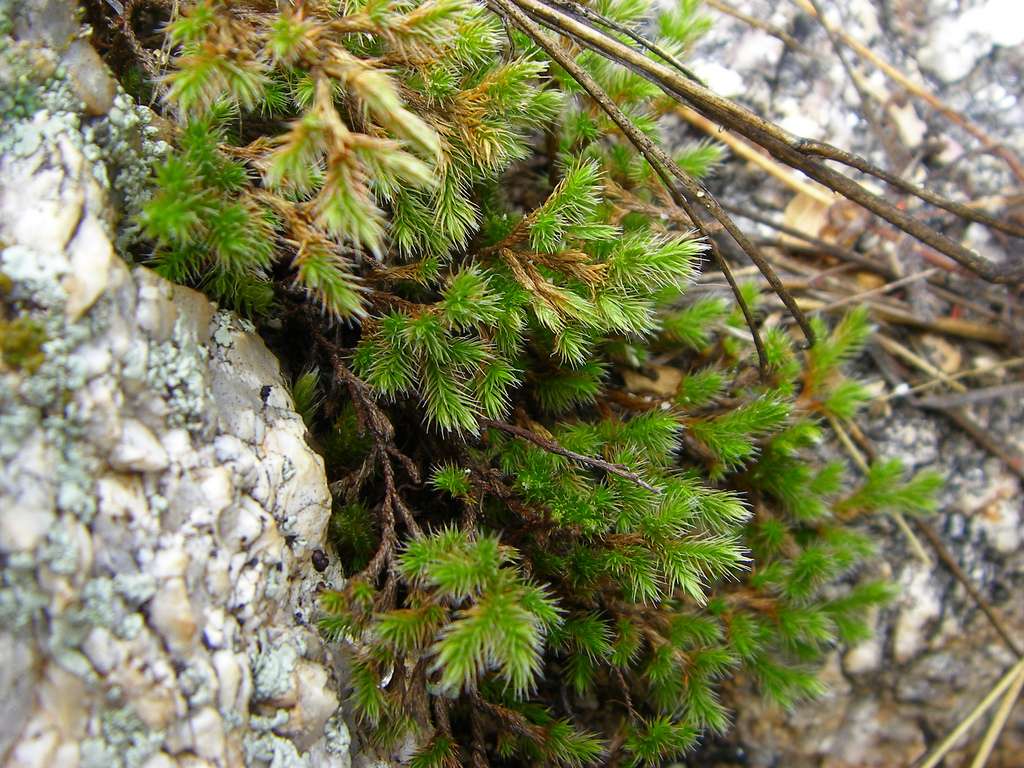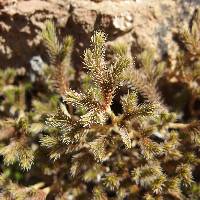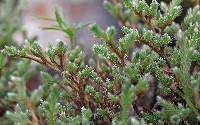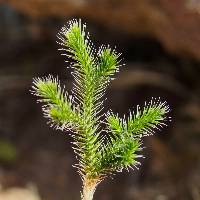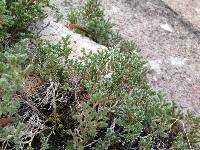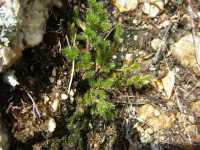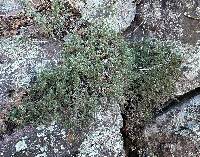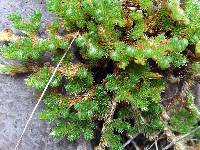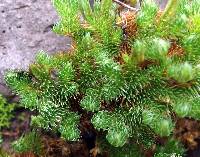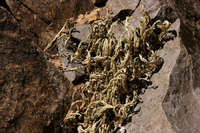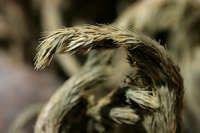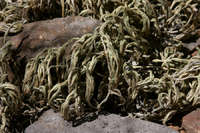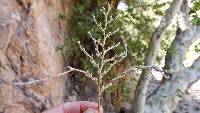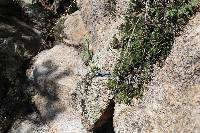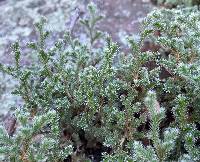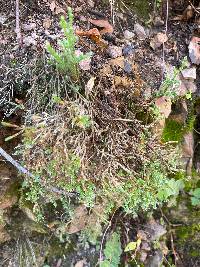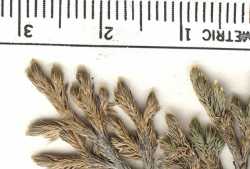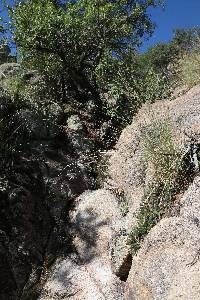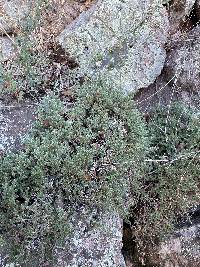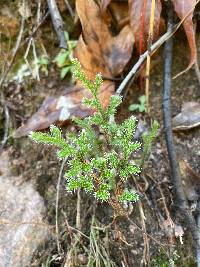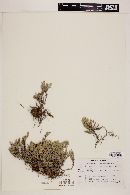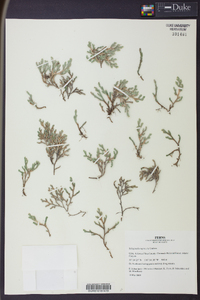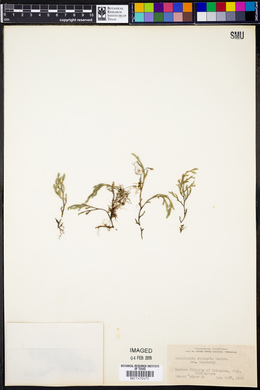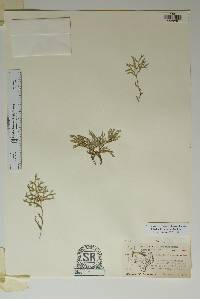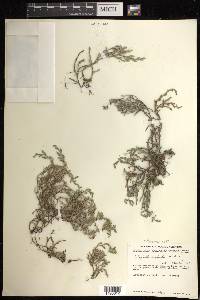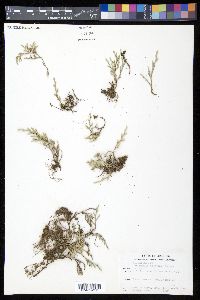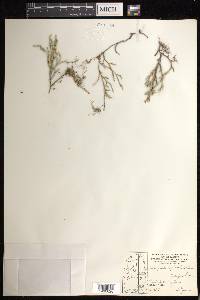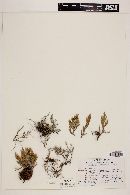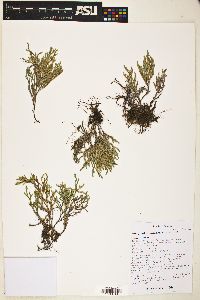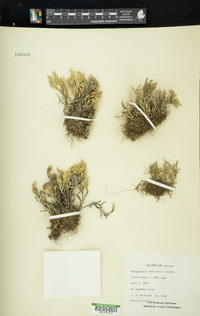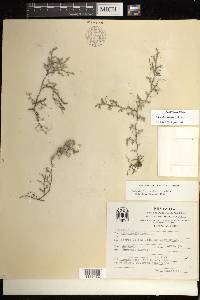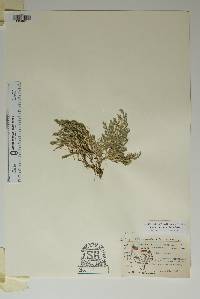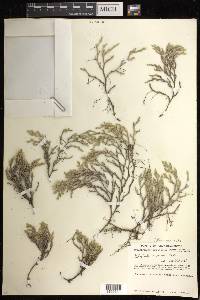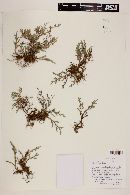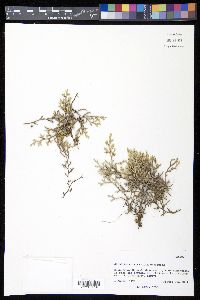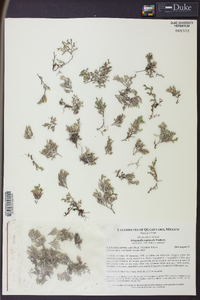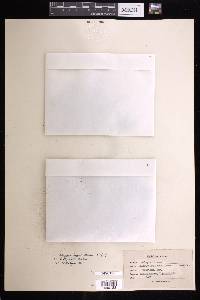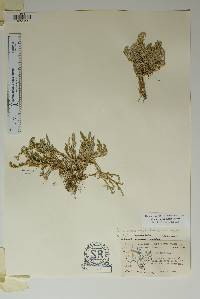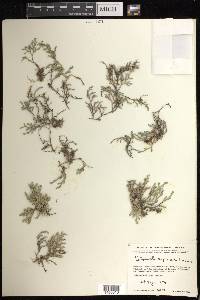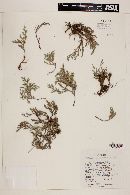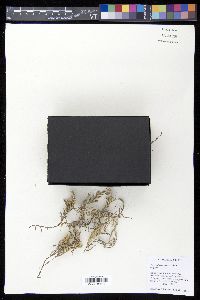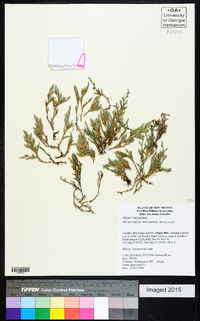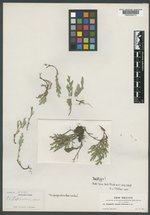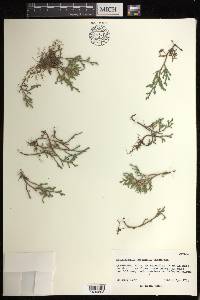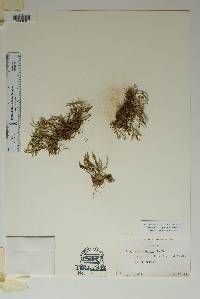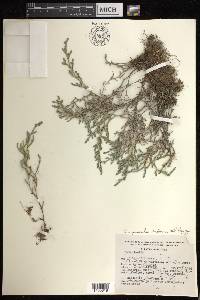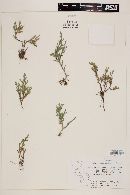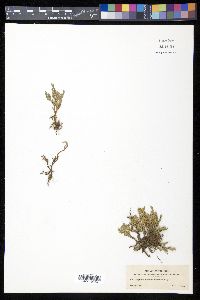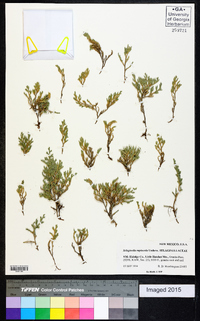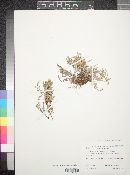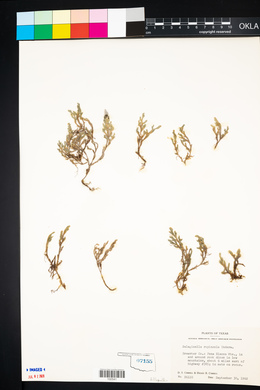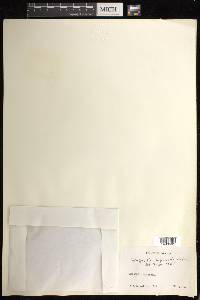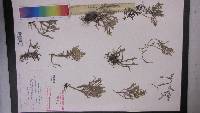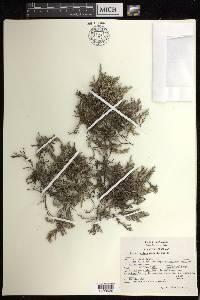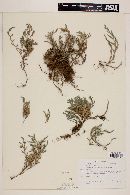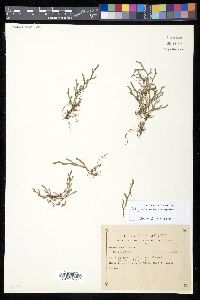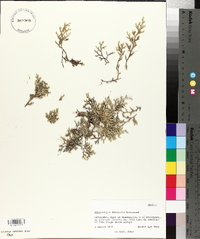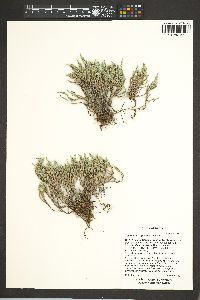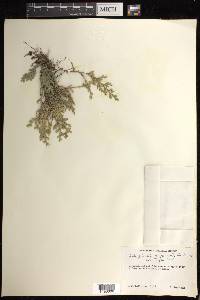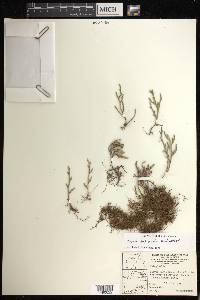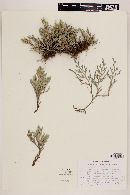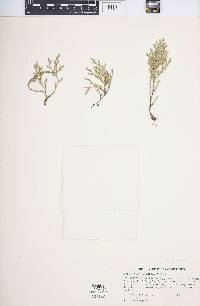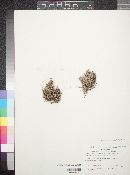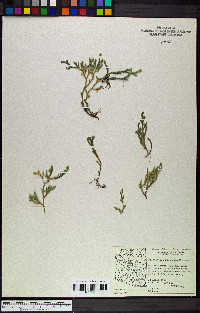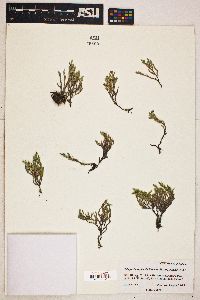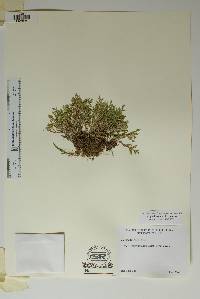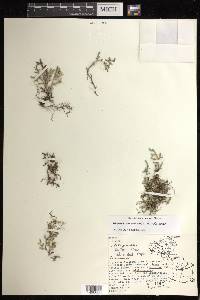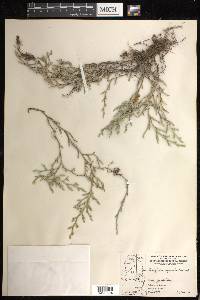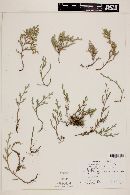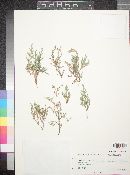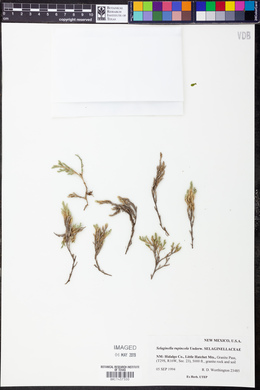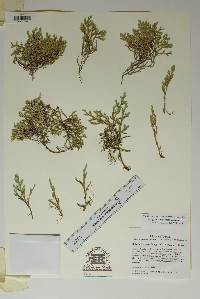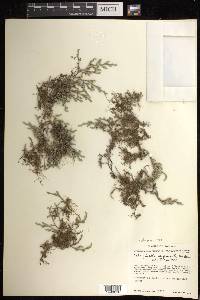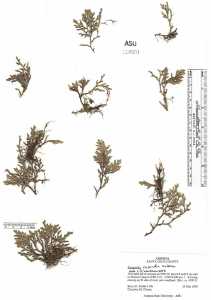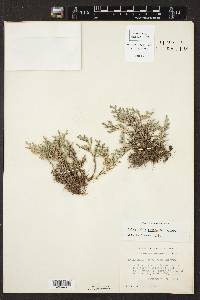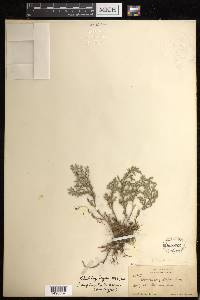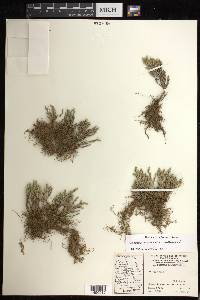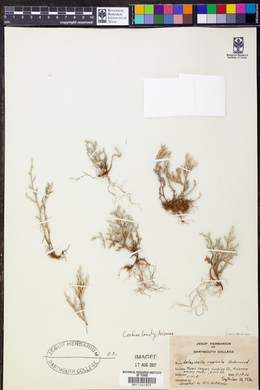Selaginella rupincola
|
|
|
|
Family: Selaginellaceae
Rock-Loving Spike-Moss, more...rockloving spikemoss, spike moss, clubmoss (es: siemprevive)
[Bryodesma rupincola (Underw.) Soják, moreSelaginella chrismarii , Selaginella chrismarii var. karwinskyana , Selaginella rupestris var. rupincola] |
Plants on rock or terrestrial, forming loose clumps. Stems radially symmetric, underground (rhizomatous) and aerial, not readily fragmenting, irregularly forked; both rhizomatous and aerial stems often with 1 branch arrested, budlike, tips straight; rhizomatous stems hard to distinguish on wholly creeping plants; aerial stems erect or ascending, sometimes decumbent to slightly creeping, budlike arrested branches restricted mostly near stem base. Rhizophores borne on upperside of stems, restricted to lower stems or throughout stem length, 0.3--0.5 mm diam. Leaves dimorphic, not clearly ranked. Rhizomatous stem leaves persistent or deciduous, tightly appressed, scalelike. Aerial stem leaves appressed, ascending, green, linear-lanceolate, 3--4.7 X 0.45--0.65 mm; abaxial ridges present; base abruptly adnate, rounded, pubescent; margins long-ciliate, cilia white to whitish, spreading, 0.1--0.2 mm; apex not keeled to slightly keeled; bristle white to whitish or yellowish to greenish near base, puberulent, 0.65--1.85 mm (1/3--1/2 length of leaves). Strobili solitary, 0.5--2.5(--3.5) cm; sporophylls lanceolate, strongly tapering toward tip, abaxial ridges prominent, base glabrous, margins short-ciliate, apex long-bristled. Exposed ledges and rock, steep slopes, rock crevices or gravelly soil; 1000--2000 m; Ariz., N.Mex., Tex.; Mexico. Selaginella rupincola is allied to S . bigelovii . It is one of the presumed parents of S . × neomexicana (see discussion). In addition to characteristics given, it can be separated from S . bigelovii in having hairs often running along the ridges of the abaxial groove, whereas S . bigelovii has nonhairy ridges on the abaxial groove.
STEMS: dimorphic, not readily fragmenting when dry, the branch tips appearing straight when dry, forming loose low clumps, differentiated into a rhizomatous, prostrate, main stem system with elongated procumbent or more commonly ascending to erect main branches, some of the basal branches of the aerial stems (and rhizomes) remaining bud-like and not elongating. RHIZOPHORES: of the aerial stems produced only below the midpoint. LEAVES: dimorphic, those of the rhizomes 1.5-2.5 mm long, ovate to narrowly ovate, persistently gray to tan, the midvein slightly ridged, the base more or less adnate (not strongly different in color to the stem), the tip sharply pointed, without a seta, the margins denticulate to nearly entire; aerial stem leaves 3.0-4.7 mm long, narrowly elliptic-lanceolate to linear-lanceolate, light grayish green, the minutely puberulent base adnate (different in color from the stem) and rounded, the tip sharply pointed, with a white to pale yellow seta 0.7-1.8 mm long, this often bent outward, denticulate, the margins relatively long-ciliate, the cilia spreading. STROBILI: 5-30 mm long, the sporophylls lanceolate, tapered to an acute tip, with a well-developed seta, the margins short-ciliate. MEGASPORES: finely rugose to rugose-reticulate, orange. NOTES: Rock ledges, cliffs, and open gravelly to rocky areas, usually on igneous or volcanic substrates or on sandstone: Cochise, Gila, Pima, Pinal, Santa Cruz cos. (Fig. 1F); 900-1850 m (3000-6000 ft); s AZ to s TX; Mex. For a discussion of possible hybridization with S. arizonica, see the treatment of that species. Tryon (1955) discussed the sporadic distribution in southern Arizona, New Mexico, and Texas of the rare S. ×neomexicana Maxon, which he thought to represent a sterile hybrid between S. rupincola and S. mutica, citing a single historical Arizona collection (Ferris s.n., March 1904, GH, US) from near Paradise (Cochise County). Aside from its abortive spores, this taxon closely resembles S. rupincola, but has leaves with shorter setae and the margins denticulate distally and with short ascending ciliation proximally. Valdespino (1993) suggested that more detailed biosystematic research is necessary to confirm the parentage of this putative hybrid. The report of S. ×neomexicana from Graham County by Buegge (2001) was based upon a misdetermined specimen of S. rupincola. REFERENCES: Yatskievych, G. and M. D. Windham. Vascular Plants of Arizona: Selaginellaceae. CANOTIA 5 (1): 39-48, 2009. General: Low growing on rock or soil, forming loose clumps of radially symmetric stems that are nearly erect and ascendingly branched, flexuous, irregularly forked, with both rhizomatous and aerial stems, with 1 branch arrested, budlike, with straight tips; rhizop Leaves: Dimorphic, not clearly ranked, rhizomatous stem leaves persistent to deciduous, tightly appressed and scalelike, spreading only near stem tips; aerial stem leaves appressed, ascending, green, linear-lanceolate, 3-4.5 mm by 0.45-0.65 mm; ridges present below; base abruptly adnate, rounded, pubescent, margins long-ciliate, cilia white to whitish, spreading, 0.1-0.2 mm; bristle white to whitish or yellowish green near base, puberulent. Sporangia: Strobili solitary, 0.5-2.5 cm, with lanceolate sporophylls, strongly tapering toward tip, with prominent lower ridges, base glabrous, margins short-ciliate, apex long bristled. Ecology: Found on dry exposed rocks and ledges, on steep slopes, in rocky crevices thought to prefer granitic substrates from 3,000-6,000 ft (914-1829 m). Notes: The tightly imbricate and grayish green leaves with whitish margins and the long stiff, yellowish white bristle at the apex help to identify this species. Etymology: Selaginella is a diminutive of Selago, the name of another similar plant, while rupincola means growing on ledges or cliffs. Sources: FNA 1993, Dittmer et al. 1954, Kearney and Peebles 1969 FNA 1993, Dittmer et al. 1954, Kearney and Peebles 1969 Common Name: rockloving spikemoss General: Low growing on rock or soil, forming loose clumps of radially symmetric stems that are nearly erect and ascendingly branched, flexuous, irregularly forked, with both rhizomatous and aerial stems, with 1 branch arrested, budlike, with straight tips; rhizophores borne on upperside of stems, restricted to lower stems 0.3-0.5 mm in diameter. Leaves: Dimorphic, not clearly ranked, rhizomatous stem leaves persistent to deciduous, tightly appressed and scalelike, spreading only near stem tips; aerial stem leaves appressed, ascending, green, linear-lanceolate, 3-4.5 mm by 0.45-0.65 mm; ridges present below; base abruptly adnate, rounded, pubescent, margins long-ciliate, cilia white to whitish, spreading, 0.1-0.2 mm; bristle white to whitish or yellowish green near base, puberulent. Sporangia: Strobili solitary, 0.5-2.5 cm, with lanceolate sporophylls, strongly tapering toward tip, with prominent lower ridges, base glabrous, margins short-ciliate, apex long bristled. Ecology: Found on dry exposed rocks and ledges, on steep slopes, in rocky crevices thought to prefer granitic substrates from 3,000-6,000 ft (914-1829 m). Notes: The tightly imbricate and grayish green leaves with whitish margins and the long stiff, yellowish white bristle at the apex help to identify this species. Ethnobotany: Unknown Etymology: Selaginella is a diminutive of Selago, the name of another similar plant, while rupincola means growing on ledges or cliffs. Synonyms: None Editor: SBuckley, 2010 |
|
|
|

